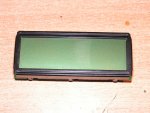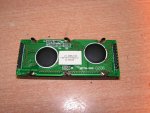Sorry, Raits999, I was so focussed on deducing the pins that I missed out answering your main question; "how can I connect this to a PICAXE and if is possible". Well, I would certainly have a go! I would start with an PICAXE AXE132 driver board and pay very careful attention to the pinouts and the circuit diagram. The AXE132 module was designed originally for 2x16 LCD displays but now is used with modified software on 4x20 line OLED displays. It does not, however, cope with two controllers as the E1 and E2 pins on your device would indicate. But there are three spare outputs on the AXE132 module that can be addressed to bring them high or low. Therefore, I would have a play around with these, connecting to the E1 and E2 pins. Bring E1 high, send the data then bring E2 high and send the rest. I suspect that you have a 4 x 40 line display, each controller handling 80 characters.
You can download the datasheet on the AXE132 from PICAXE and that gives a useful little circuit diagram in the last few pages if you want to try and attach something like an 18M2 yourself. Download the code for the AXE134 and I think that this could probably be modified to drive the display that you have if you apply a little ingenuity.
I am guessing that the display is, in fact, character-based. A graphic based LCD is less likely and is more involved in the software side.
So, how to start? Firstly, make sure that you can get the display up and running. Apply 5v to the Vcc/Vdd terminals and run a further connection through a 10K variable resistor to the Vee terminal. Try adjusting the VR and see if the display goes from transparent to black. If it does, then you are in business. Then it is a question of applying the AXE132 circuit diagram with the additional connections that I mentioned above. Patch the code and see what happens...
Also, before you do actually start, wait a day or two to see if anyone finds fault in what I have suggested or if anyone on this forum has any better ideas. Watch this space...and good luck! - I think that you are in with a chance.




